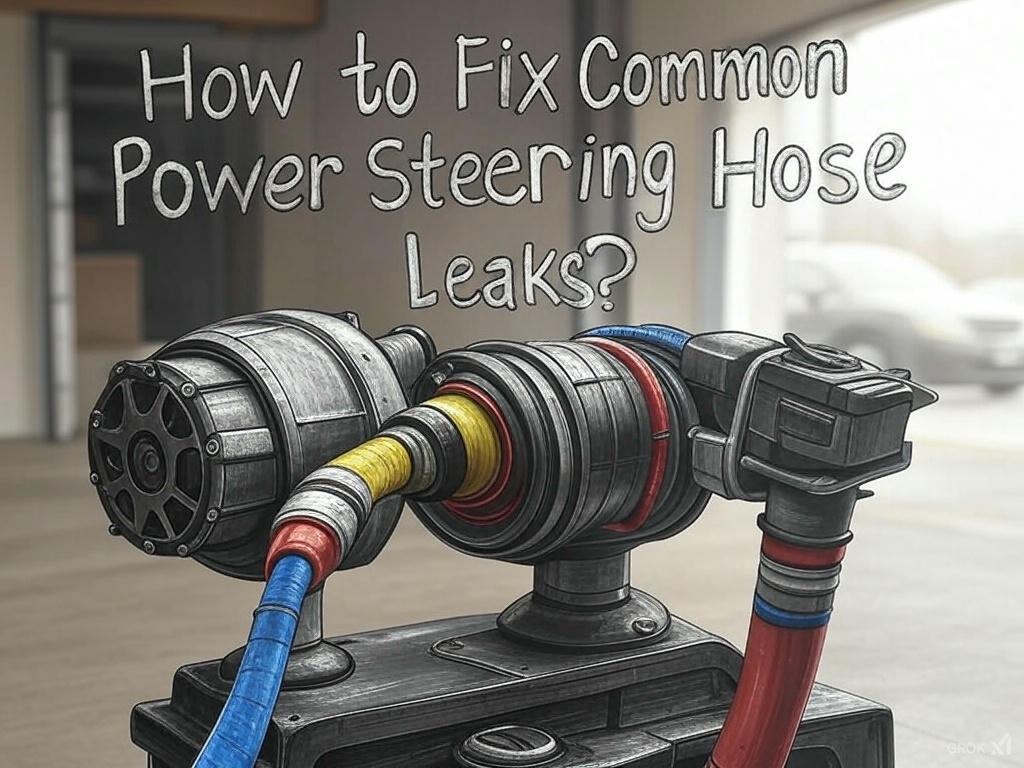Power steering hoses are vital components of a vehicle’s power steering system. They help transmit hydraulic fluid under pressure from the power steering pump to the steering mechanism, making it easier to steer your vehicle. If you’ve ever experienced difficulty turning your steering wheel, there’s a good chance your power steering system has an issue—possibly with the hoses. These flexible, high-pressure hoses are subject to wear and tear over time. When damaged, they can lead to a variety of steering problems, including leaks, hard steering, and even a total loss of steering assist.
In this article, we will delve into the essential aspects of power steering hoses, from their functions and types to how to maintain and repair them. Let’s get started!
What Are Power Steering Hoses?
Power steering hoses are flexible tubes that carry hydraulic fluid under high pressure between the power steering pump and the steering gear. The power steering pump generates hydraulic pressure, which is used to assist in turning the steering wheel. The hoses play a vital role in carrying this fluid and keeping the system running smoothly.
These hoses are made of synthetic rubber or reinforced fabric to ensure they can handle high-pressure environments. The hydraulic fluid inside the system helps to reduce friction in the steering mechanism, making it easier to turn the wheel.
While they seem simple, these hoses are crucial to vehicle safety and performance. If they fail, the steering system can malfunction, causing difficulty steering or total failure.
How Long Do Power Steering Hoses Last?
On average, power steering hoses last anywhere from 8 to 10 years. However, their lifespan can vary depending on factors such as the make and model of the vehicle, the climate, and driving conditions. For example, hoses may degrade faster in areas with extreme heat or cold.
Here are a few signs that might indicate your hoses need replacing sooner than expected:
- Frequent fluid leaks: This is a common sign of wear and tear.
- Unusual steering noises: A squealing or whining sound often points to a problem with the power steering system.
- Fluid contamination: If the fluid looks discolored or has a burnt smell, it could signal that the hoses are breaking down inside.
Power Steering Hose Types
There are primarily two types of power steering hoses in modern vehicles:
- High-pressure hoses
- Low-pressure hoses
These hoses perform different functions but are both equally important. Here’s a quick breakdown:
| Type | Description |
| High-Pressure Hose | Carries pressurized fluid from the power steering pump to the steering mechanism. These hoses are reinforced to withstand higher pressure. |
| Low-Pressure Hose | Returns fluid to the power steering reservoir from the steering mechanism. This hose operates under much lower pressure. |
Both types of hoses are essential for the power steering system to function efficiently. The high-pressure hoses are usually located closer to the pump, while the low-pressure hoses return fluid from the steering rack or gear.
Signs You Need a New Power Steering Hose
Replacing a power steering hose is essential if you notice any of the following signs:
- Fluid leaks: This is one of the most obvious signs. Hydraulic fluid under the car or around the hoses means there’s a problem.
- Difficulty turning the wheel: If the steering becomes stiff, it could mean the fluid is not circulating properly due to a damaged hose.
- Whining or squealing noises: These sounds may occur when the fluid is low or the pump is working harder than usual to compensate for the hose issue.
- Steering wheel vibration: A damaged hose may cause an abnormal flow of fluid, leading to vibrations in the steering wheel.
Common Power Steering Hose Problems
When power steering hoses are not properly maintained, a variety of issues can occur, including:
- Cracks and bulges: These can develop over time due to heat and pressure. They often go unnoticed until fluid begins to leak.
- Fluid leaks: This happens when the hose has either worn down or developed a tear. It’s crucial to address leaks immediately as they can reduce the effectiveness of the entire steering system.
- Kinks or bends: Improper installation or damage can cause the hose to bend sharply, which restricts fluid flow and puts undue stress on the steering pump.
Regular maintenance and inspections can prevent most of these issues from developing.
Power Steering Hose Leak Symptoms
Leaking power steering fluid is one of the most common symptoms of a problem with the power steering hose. Here’s how to identify a leak:
- Visible puddles or stains: Look under your car for any signs of fluid. Power steering fluid is often reddish and oily to the touch.
- Low fluid levels: If the fluid in the reservoir keeps dropping, you may leak. It’s important to top it up immediately to avoid further damage.
- Increased steering difficulty: Leaking fluid can lead to a drop in hydraulic pressure, making the steering feel stiff and unresponsive.
- Whining noises: A whining or groaning noise, especially while turning, is a sign of air in the system, which is usually caused by low fluid levels due to a leak.
How to Install Power Steering Hoses
If you’re ready to tackle a power steering hose replacement, here’s a basic overview of the process:
- Lift the car: Use a jack to raise the car and ensure it’s stable on a solid surface.
- Locate the hoses: The high-pressure hose will typically be close to the power steering pump, and the low-pressure hose is near the steering gear.
- Drain the fluid: Before removing the hoses, drain the power steering fluid to avoid spills.
- Remove the damaged hoses: Carefully unbolt and remove the damaged hoses. Use a wrench to loosen any fittings.
- Install the new hoses: Align the new hoses with the fittings and tighten them to the manufacturer’s recommended torque specification.
- Refill the fluid: Refill the power steering reservoir and bleed the system to remove any air pockets.
| Step | Description |
| Drain Fluid | Ensure all fluid is drained to prevent spills and contamination during hose replacement. |
| Remove Old Hoses | Loosen and remove the old hoses, checking for any rust or damage in the fittings. |
| Install New Hoses | Attach and securely tighten the new hoses, making sure they’re free from kinks or tight bends. |






